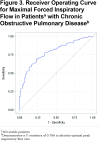Spirometry Measurement of Peak Inspiratory Flow Identifies Suboptimal Use of Dry Powder Inhalers in Ambulatory Patients with COPD
- PMID: 31189057
- PMCID: PMC6872217
- DOI: 10.15326/jcopdf.6.3.2018.0163
Spirometry Measurement of Peak Inspiratory Flow Identifies Suboptimal Use of Dry Powder Inhalers in Ambulatory Patients with COPD
Abstract
Objectives: Determine the prevalence of suboptimal peak inspiratory flow rate (PIFR) and associated patient characteristics and compare PIFR measurements obtained with spirometry and In-Check DIAL® device in ambulatory patients with COPD.
Methods: Patients underwent PIFR measurement with In-Check DIAL® device and pulmonary function testing with calibrated equipment. Group characteristics and lung function were compared for patients with suboptimal (≤ 60 L/min) and optimal (> 60 L/min) PIFR. Receiver operating curve analysis determined the best maximal forced inspiratory flow (FIF max) value in identifying optimal PIFR by gender and height.
Results: From July 1, 2016 to January 31, 2018, a total of 303 patients with chronic obstructive pulmonary disease (COPD) had PIFR and pulmonary function measurements. Group mean age was 65.5 ± 11.3 years with equal gender distribution. Suboptimal PIFR was observed in 61 (20.1%) patients. A significant correlation was observed between PIFR and FIF max, inspiratory capacity and residual volume (RV) to total lung capacity (TLC) ratio. In the suboptimal PIFR group, mean FIF max measured by spirometry was significantly less compared with the optimal PIFR group; 178.5 ± 56.9 L/min and 263.4 ± 89.9 L/min, respectively (p<0.0001). Receiver operator curve analysis of FIF max to identify an optimal PIFR yielded an area under the curve of 0.79. Males < 65 inches had a suboptimal PIFR in 16.7 % of the male cohort, while females < 65 inches had a suboptimal PIFR in 27.4 % of the women.
Conclusions: Suboptimal PIFR was present in 1 in 5 stable patients with COPD and was more frequent in short statured females. Spirometry determined FIF max was associated with PIFR based on gender and height.
Keywords: chronic obstructive pulmonary disease; copd; dry powder inhaler; inhalation therapy; peak inspiratory flow rate; pulmonary function test.
JCOPDF © 2019.
Conflict of interest statement
Dr. Gulshan Sharma served on the advisory board of Astra Zeneca, Mylan, Boehringer Ingelheim and Sunovion Pharmaceuticals. The remaining authors have no potential conflicts of interest related to the content of manuscript.
References
-
- Dolovich MB,Ahrens RC,Hess DR,et al. Device selection and outcomes of aerosol therapy: evidence based guidelines. Chest. 2005;127(1):335-371. doi: https://doi.org/10.1378/chest.127.1.335 - PubMed
-
- Laube BL,Janssens HM,de Jongh FHC,et al. What the pulmonary specialist should know about the new inhalation therapies. Eur Resp J. 2011;37(6):1308-1331. doi: https://doi.org/10.1183/09031936.00166410 - PubMed
-
- Bourbeau J,Bartlett SJ. Patient adherence in COPD. Thorax. 2008;63(9):831-838. doi: https://doi.org/10.1136/thx.2007.086041 - PMC - PubMed
-
- Dhand R,Mahler DA,Carlin Bw,et al. Results of a patient survey regarding COPD knowledge, treatment experiences and practices with inhalation devices. Resp Care. 2018;63(7):833-839. doi: https://doi.org/10.4187/respcare.05715 - PubMed
-
- Loh CH,Peters SP,Lovings TM,Ohar JA. Suboptimal inspiratory flow rates are associated with chronic obstructive pulmonary disease and all-cause readmissions. Ann Am Thorac Soc. 2017;14(8):1305-1311. doi: https://doi.org/10.1513/AnnalsATS.201611-903OC - PubMed
Grants and funding
LinkOut - more resources
Full Text Sources
Other Literature Sources



